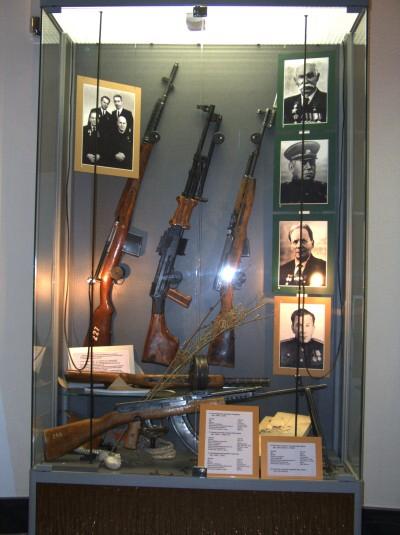Pic.4-11 Left to right: SVT-40, RPD-44 (light machine gun by Degtyrev),
SKS-45 (Self-loading carbine by Simonov)
Bottom: Submachine gun by Degtyarev, with bipod.
Above it: Assault rifle by Sudayev, 1944 (prototype).

There was yet another Soviet rifle which was highly prized capture by Nazi troops - it's SVT-40 (samozaryadnaya vintovka Tokareva) self-loading carbine designed by Fedor Tokarev and being manufactured between 1941 and 1945 (featured in the next showcase, first on the left).
Many SVT-40 rifles were sent back to Germany for further study and contributed to the development of Germany's semi-automatic rifles. There are many pictures in books of Nazi troops on the eastern front carrying the SVT-40 (or the German nomenclature of SIG.259r).
There were many reasons for this fact:
1) captured ammo was abundant,
2) the SVT-40 rifles were very accurate,
3) very reliable in properly trained hands, and
4) provided a higher rate of fire than the German Kar 98k rifle.
It was an irony that the Red Army gave the German Army some of their best weapons of the war.
In Red Army the SVT-40 did not meet with high success. This is attributed to the complexity of functionality in comparison to the typical Mosin-Nagant bolt action rifle.
In the Red Army, there was also the added problem that men were often thrust into combat with little training, especially in the niceties of weapon maintenance. The SVT was a complicated machine, ill-suited to be used by conscript recruits.
A few fully automatic weapons were produced, but proved too troublesome for further development. Still no doubt SVT-40, among other works of Soviet Small Arms designers, laid ground for AK-47 to emerge.
Speaking of other small arms being considered highly prized captures by parties involved in military conflicts...
In his interview Kalashnikov once mentioned what among many letters he receives by means of his Internet site there are sometimes messages from US Vietnam war veterans who tell him that they had so much trouble with the US-made M-16 rifle jamming up that they would often recover the AK-47s from killed Viet Cong and NVA, and use these instead.
Our editor also confirms the fact - he heard about that from his ex--brother in law, who was there.
|
|
|
However, history repeats itself.. At the Museum there is a documentary on the Russo-Finnish War of 1939-1940. In that film the narrator bitterly commented on Russian troops having no small automatic weapons - like Finns who had the "Suomi" KP/-31 submachinegun. Actually, there was a small automatic weapon developed in Russia in mid 1930s which looked almost exactly as "Suomi" gun, but just prior to Russo-Finnish war it was called off Red Army - the reason was unclear. Russian soldiers had to fight against Finns with old fashioned and heavy rifles.
According to Finnish author P. T. Kekkonen: "At other times one gunner and a couple of magazine-filling assistants struggled against a full infantry company - 200 Russians - killing almost half of their troop and wounding many others. Some Finnish writers of war and remembrance novels say they have given too small numbers of Killed In Action enemy soldiers in their books because "nobody can believe my eye-witness' claim that one submachine gunner can slaughter eighty-five enemy soldiers during a skirmish lasting less than thirty minutes".
|
|
|
So Russian soldiers got no choice but to use captured "Suomi" guns, too, which they were getting from Finnish war casualties.
For obvious reasons, reports of Americans using AK-47s in Vietnam and Russians using Suomi guns in Finland were not widely publicized.
|